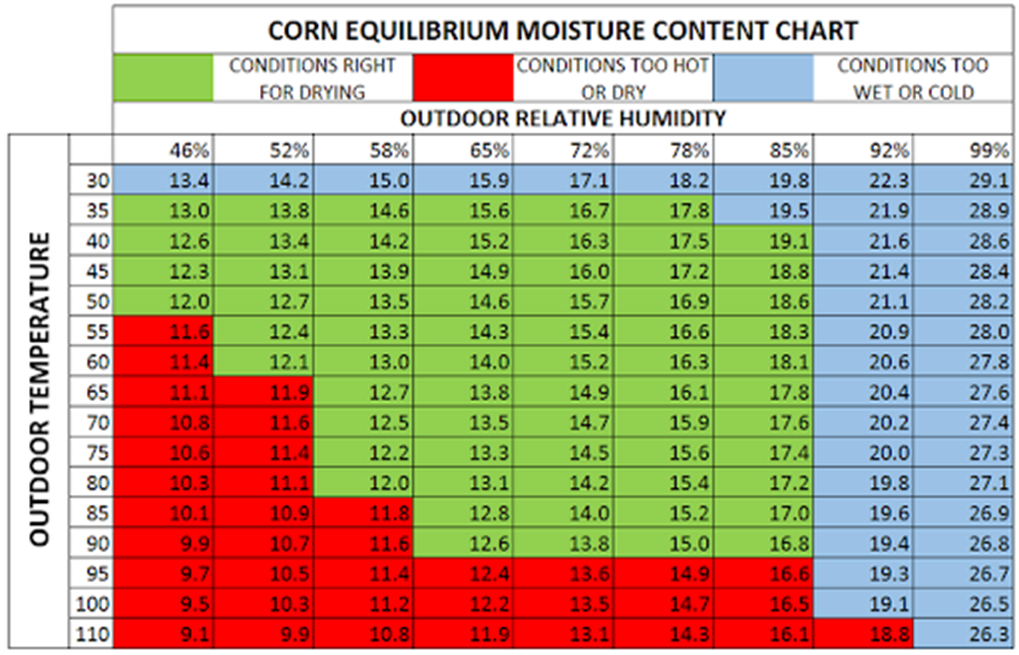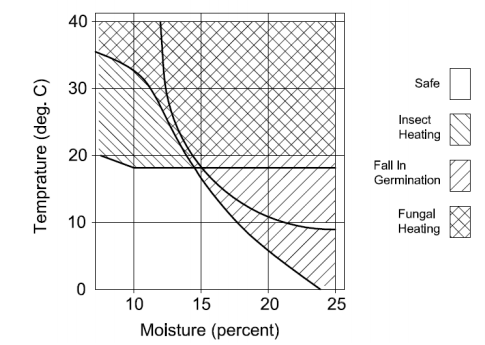In South Africa, grain is sometimes cultivated in areas where the climatic conditions are not favourable for the cultivation thereof. Problems are especially experienced if the climatic conditions during the ripening stage of the grain are unfavourable. In the summer rainfall areas of South Africa, it often happens that wheat must be harvested while it is still wet in order to protect the quality thereof.
Such grain must then be dried artificially before it can be stored safely. With the expansion of wheat and maize production in the summer rainfall areas and with modern harvest techniques, the extent of South Africa’s grain harvest that must be dried artificially, has increased so much that in some years up to 90% of the wheat deliveries at some receiving points must be dried. The average percentage of maize that must be artificially dried, is approximately 5.5% per year.
In the winter rainfall areas wheat and barley must also be harvested when it is still wet because strong winds during harvesting can let the grain fall out and/or cause the plant to fall over and thus hamper the harvesting process.
Due to the fact that wet grain cannot be stored safely, silos attempt not to store grain with a too high moisture content. Payment, however, takes place on a dry mass that is determined against the maximum moisture content that is acceptable according to the regulation for the specific grain type. In the case of maize, it is 12.5%. The amount of moisture in grain is always expressed as a percentage. The percentage moisture of products in a normal air-dry condition is an important characteristic.
Moisture in a silo comes from three sources:
The stored grain itself and any weed seeds or impurities:
Grain is a living organism and releases moisture as it respires. This is carried upwards in a silo by convection currents of air. These air currents are created by the temperature difference between the warm grain in the centre of the silo and cool silo walls, or vice versa. When grain is stored at less than 12% moisture and is free of insects, the moisture increase in the upper layers of the grain will not be significant. If it is stored at above 12% moisture content, enough moisture may be carried into the upper layers to place the grain at risk of going mouldy.
Respiration of insects or mites in the grain:
Insect activity releases moisture and heat into the spaces between the grains. Moisture builds up faster and to higher levels from insects than from grain respiration alone.
Moisture carried into the silo headspace may condense on a cold roof and fall back as free water. This will sometimes cause a ring of grain to germinate against the silo wall. When the grain contains insects in large numbers, increased moisture can cause a damp mouldy layer across the top of the grain which can be difficult to outload.
Water entering through a leak:
Water entering through structural damage will increase grain moisture content to the point where mould growth occurs. This moisture may also migrate to other areas. Insects will develop more rapidly in these high moisture zones.
The Moisture Content of Grain
Moisture content in grain is defined as the amount of water that is absorbed into the grain kernel as a percentage of the total weight of the grain kernel.
The moisture content of a grain is typically provided on a "wet basis" (wb) and is calculated as:

Moisture is the single biggest cause of the decrease in grain quality. The speed of deterioration in the quality of stored grain is closely related to the amount of moisture. Also, high moisture content grain, when coupled with high foreign material contents and fines, can lead to material flow and handling problems. Therefore, it cannot be stored safely above a certain percentage of moisture.
Equilibrium Moisture Content of Grain
Each grain variety displays a characteristic water vapour pressure at a given temperature and moisture content. When the vapour pressure of the water held by a product is equal to the water vapour pressure of the surrounding air, the moisture content of the product is the equilibrium moisture content (e.m.c.).
 |
When the vapour pressure is less in the air than in the grain there is a drying effect and the grain gives up moisture until the air and grain pressures are in equilibrium. |
Similarly, when the vapour pressure of the grain is less in the grain that in the air, the grain takes up moisture from the air and becomes wetter. This process continues until both pressures are the same.
The e.m.c. is important, as drying may be carried out unnecessarily resulting in a reduction in the capacity of a given drying system, a higher cost of drying, and an economic loss.
The moisture content of grains is an essential property in food storage. The moisture content that is safe for long-term storage is 12% for corn, sorghum, rice and wheat and 11% for soybean.
At a constant relative humidity of air, the e.m.c. will drop by about 0.5% for every increase of 10 °C air temperature.
Mould growth requires moist conditions, usually above about 70% relative humidity, and warm temperatures. To reduce the potential for mould growth, the grain moisture content should be below the equilibrium moisture content (e.m.c.), at 60% to 65% relative humidity.
The e.m.c. of maize at 21 degrees Celcius and 65% relative humidity is about 13.5%, and at 10˚C, the e.m.c. is about 15%. If you can keep stored maize below 10˚C, you can store it at 15% moisture. But if the temperature will be warmer, then the recommended storage moisture content is about 13.5%.


Moisture content of the grain can change with the environment in which it is stored, and this should be monitored to help ensure the overall condition of the grain.
Potential Damage Caused by Moisture
The figure below illustrates the potential issues with stored grain at a range of temperatures and moisture contents. As the temperature rises, the safe level of moisture in the grain must be reduced for good quality storage.

Moisture Movement
A general problem with long-term storage is moisture movement in the grain mass. Moisture migration is the result of convection currents which are caused by temperature differences in the grain mass. Moisture migration is especially serious if grain is not adequately cooled after drying and moisture moves to the top of the bin through convection currents. Usually this moisture migration is only noticed in the spring when temperatures start to rise and then it is very difficult to rectify it without aeration.
The first indication of moisture migration is usually moist grain on the grain surface area which later develops into a hard crust that forms on top of the other grain. If this grain is not aerated, it could result in huge losses in grain quality.
Managing Moisture Levels
Grain going into long-term storage should be dried and cooled rapidly after harvest. The allowable storage time (AST) is an estimate of the life of the grain until it has deteriorated enough to affect grain quality. Most of the silos have dryers that enable them to extract moisture from grain. It is thus important to know how much water must actually be removed during drying.
Example:
For this calculation, 12.5% moisture will be regarded as dry and safe for storage. To therefore determine the quantity of water that must be removed during drying, the following calculation must be used:
|
𝑀𝑎𝑠𝑠 𝑜𝑓 𝑊𝑎𝑡𝑒𝑟 =𝑀𝑎𝑠𝑠 𝑡𝑜𝑡𝑎𝑙 (𝑀𝑖 − 𝑀𝐹) [1 − (𝑀𝑓 ÷ 100)] 𝑥 100 |
Where: Mi = Moisture initially Mf = Moisture final |
It is thus possible to determine the mass of water that is present in silo bins.
Assume that a silo handles 90 000 tons of grain per year, of which 50% must be dried, then the average moisture content of the wet grain is 16% and must be dried to 12.5%. The mass of water that must be withdrawn is then:
|
Mi = Moisture initially (16%) Mf = Moisture final (12.5%) Mass = ton |
𝑀𝑎𝑠𝑠 𝑜𝑓 𝑊𝑎𝑡𝑒𝑟 𝑓𝑟𝑜𝑚 𝑤𝑒𝑡 𝑔𝑟𝑎𝑖𝑛 = (50 ÷ 100)𝑥 90 000 𝑥 (16 − 12.5) [1 − (12.5 ÷ 100)] 𝑥 100 |
Thus:
𝑀𝑎𝑠𝑠 𝑜𝑓 𝑊𝑎𝑡𝑒𝑟 𝑓𝑟𝑜𝑚 𝑤𝑒𝑡 𝑔𝑟𝑎𝑖𝑛 = (50 ÷ 100)𝑥 90 000 𝑥 (16 − 12.5)
[1 − (12.5 ÷ 100)] 𝑥 100
= 157 500
87,5
= 1800 𝑡𝑜𝑛 𝑤𝑎𝑡𝑒𝑟
= 1 800 000 𝑙𝑖𝑡𝑟𝑒s 𝑤𝑎𝑡𝑒𝑟
If the remaining 50% of the grain received that is accepted as dry contains 14% moisture, then the quantity of water is calculated to a 12.5% moisture content:
𝑀𝑎𝑠𝑠 𝑜𝑓 𝑊𝑎𝑡𝑒𝑟 𝑓𝑟𝑜𝑚 𝑤𝑒𝑡 𝑔𝑟𝑎𝑖𝑛 = (50 ÷ 100)𝑥 90 000 𝑥 (14 − 12.5)
[1 − (12.5 ÷ 100)] 𝑥 100
= 67 500
87,5
= 771 𝑡𝑜𝑛 𝑤𝑎𝑡𝑒𝑟
= 771 000 𝑙𝑖𝑡𝑟𝑒s 𝑤𝑎𝑡𝑒𝑟
It is possible that in a good agricultural year where grain is not dried quickly, more than 1 000 ton of water could be present in the silo. This makes it difficult to manage the grain and it is thus not possible to maintain grain quality without special precautions such as aeration and monitoring.
Considering the extended period that grain can be stored at silos, it is necessary that the moisture content is controlled continuously.
Click here to view a video that explains what happens when grain is dried.